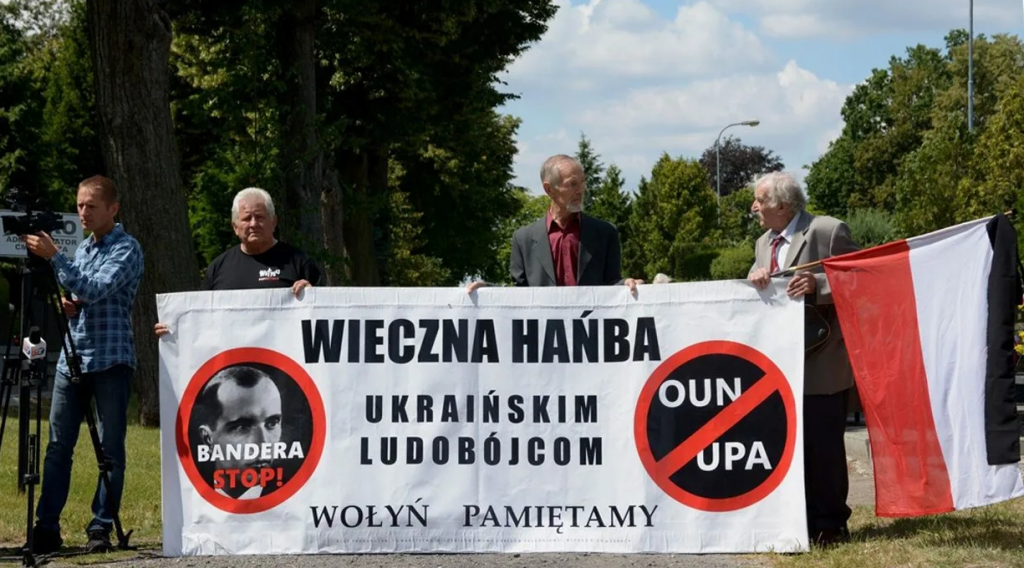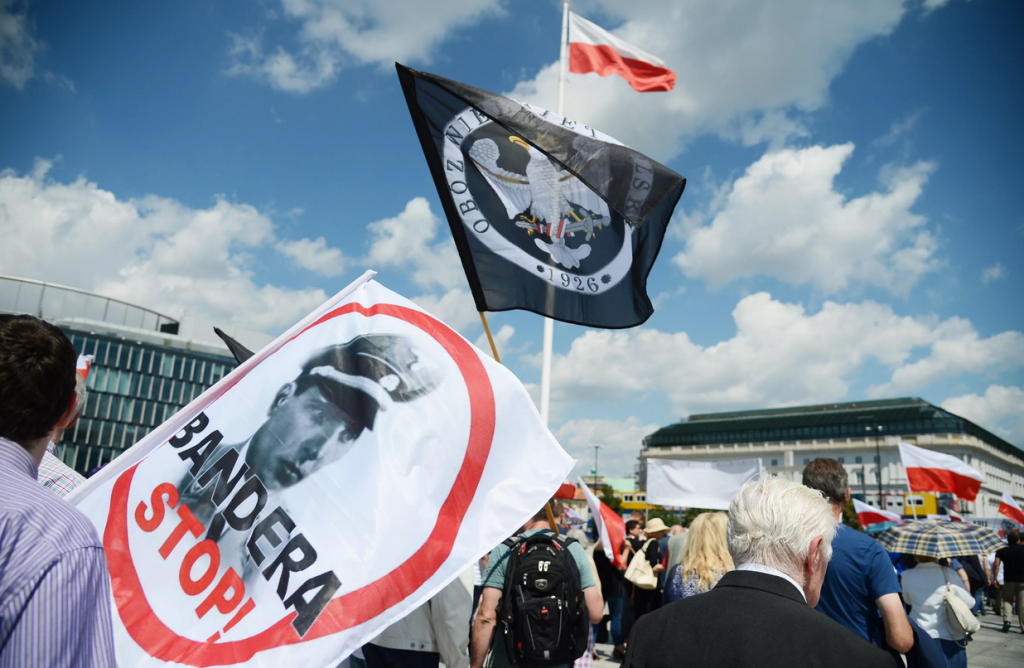Background of Volyn massacre
Volyn massacre ( Polish Rzeź wołyńska, in Ukrainian historiography Volyn tragedy, Ukrainian Volyn tragedy, Polish Tragedia Wołynia ) – mass destruction by the Ukrainian Insurgent Army – OUN of the ethnic Polish civilian population and, on a smaller scale, civilians of other nationalities living in Western Ukraine, on the territory of Volyn (Rivne, Volyn and the northern part of the Ternopil region) (until September 1939, under the control of Poland), which began in March 1943 and peaked in July of that year. The retaliatory actions of the Polish side, begun in the late summer of 1943, led to significant casualties among the Ukrainian civilian population.
From the second half of 1943, Ukrainian nationalists began to exterminate the Polish population already in the territory of Eastern Galicia (now Lviv, Ivano-Frankivsk and Ternopil regions). The first mass killings in this region took place as early as October 1943, and their intensification took place in February 1944. By the summer of 1944, anti-Polish actions covered the entire territory of Eastern Galicia and even began in Zakerzonia.
It is the most bloody episode of the Polish-Ukrainian conflict in the middle of the 20th century, which many historians (primarily Polish) stand out from the general picture of the Polish-Ukrainian armed conflict. Quite often, Polish historians interpret these events solely as an anti-Polish action of the UPA, while Ukrainian historians focus on the motives that led to the UPA carrying out this action, and also pay considerable attention to the retaliatory actions of the Home Army against the civilian Ukrainian population, including on the territory of Poland. The Polish Sejm qualifies the Volyn massacre as genocide of the Polish population.
Interwar Poland

The aggravation of the Polish-Ukrainian conflict in the first half of the 20th century was connected with the national situation in the Second Polish Republic. The Paris Peace Conference of 1919 allowed Poland to occupy Western Ukrainian lands, and the Riga Peace Treaty of 1921 secured the annexation of Western Ukraine to Poland against the will of the Ukrainian liberation movement, which was striving for independence. Ukrainians from the army of Symon Petliura, who helped the Poles defend their independence, were thrown into concentration camps.
The new Polish state, under the rule of Józef Piłsudski, took the form of authoritarianism. The Polish government considered Galicia and Volhynia as originally Polish lands, so it tried to increase its influence here. For this, colonization took place ( siege – the resettlement of Poles to Volhynia on lands that were taken from local Ukrainians), pacification (punitive operations against Ukrainian nationalists), restriction of Ukrainians in the rights to education (they were not hired for prestigious work – they were almost officially “second-class” people), and its radical Polonization, the destruction of Ukrainian churches (especially in the Kholm region). From 1932 to the middle of 1934, 111,000 Ukrainians passed through Polish prisons. 8073 prisoners were tortured. 734 people were killed without trial or investigation, 257 people were sentenced to death.
The Ukrainians, of course, were not going to be limited to passive resistance. In 1929, a number of Ukrainian nationalist groups created the Organization of Ukrainian Nationalists in Vienna. This organization was called upon to strive for “restoration, improvement, defense and expansion of the Independent Cathedral Ukrainian National State”, which was to cover all Ukrainian ethnographic territories. From the very moment of its foundation in 1929, the Organization of Ukrainian Nationalists considered Poland as the main enemy. The leading cadres of the OUN were former officers of the Western Ukrainian People’s Republic (ZUNR), which in 1919 was occupied by Poland with the support of the Entente countries. Hence the sharp anti-Polish sentiments of the top and ordinary members of the OUN. In 1929-1939, the OUN carried out a number of high-profile terrorist attacks against the highest officials of the Polish state, including the leader of Poland, Marshal Jozef Pilsudski. It culminated in the assassination by Ukrainian nationalists of the Minister of the Interior of Poland, Bronisław Peracki, in 1934. The OUN was able to acquire many supporters in Western Ukraine occupied by Poland due to the anti-Ukrainian chauvinist policy of the Polish authorities.
The Poles helped Hungary to occupy the Carpathian Ukraine in March 1939 by sending sabotage detachments to Transcarpathia across their southern border. The fighters of the ” Carpathian Sich”, (an armed formation that defended the region), especially the natives of Galicia who were captured by the Poles, were often shot on the spot without trial or investigation, the Poles did not bother to comply with conventions on the laws and customs of war and in relation to those who tried cross the border.
On the eve of the war, Poland’s neighbors – the Third Reich and the USSR planned to use the Ukrainians for their predatory purposes, and in this case, the actions of the latter would certainly have caused a sharp aggravation of the already tense Polish-Ukrainian relations. Having embarked on the path of confrontation with Poland, the Nazis decided to use the “Ukrainian card”. To do this, they agreed to improve relations with the Ukrainian emigration, which they promised to support the political aspirations of Ukrainian groups, to provide them with material and moral assistance. Long-term contacts of the Organization of Ukrainian Nationalists with the Abwehr gave a result: on August 15, 1939, a sabotage detachment was formed from the OUN, code-named Bergbauernhilfe(Help mountain peasants) under the command of Colonel Roman Sushko. The detachment was intended to incite an anti-Polish uprising in Western Ukraine before the German invasion of Poland. However, a week later the situation changed radically: after the conclusion of the Molotov-Ribbentrop Pact, the Germans no longer worried about Western Ukraine.
The Polish-Ukrainian conflict in the Lublin region and its connection with the Volyn massacre


One of the most controversial historical issues preceding the Volyn massacre is the ethnic cleansing of the Ukrainian population by the Poles in Zakerzonia (in the Kholm and Lublin regions). The inconsistency lies in the different interpretation of the time of these events – whether they preceded the actions in Volhynia, or occurred after they began. As archival documents of one of the OUN underground members testify, Ukrainian refugees from the Western Bug turned to him with a request to protect them from Polish terror. As before, the leaders of the OUN entered into negotiations with the Polish underground with a proposal for a peaceful solution to all problems, but did not receive a positive response. Russian historian Alexander Gogun believes that the Polish terror in the Lublin region was the last straw that prompted the OUN to start anti-Polish actions in Volhynia. The Polish historian Grzegorz Motyka believes that the mass killings of Ukrainians by the Polish underground in the Kholm region began only in the spring of 1943 as a response to the actions of the UPA, and before that their goal was not to “cleanse” the Lublin region from Ukrainians, but to resist the German eviction operation. The head of the security service (SD), SS and police officer of the Lublin district of the General Government, Odilo Globocnik, planned the creation of an exemplary German colony “Himmlerstadt” on the territory of the Zamoysky Povet, populated by peasants from Germany (Reichsdeutsch), persons of German nationality (Volksdeutsch) and the Dutch. To protect the Germans, Ukrainians were to be placed on the borders of the colony. During the resettlement action, which began on November 27, 1942 and took place until mid-February 1943 in Polish villages, from where the Poles were previously evicted, Ukrainian peasants were placed. Tens of thousands of Poles, evicted from their homes in winter, replenished the AK and began retaliatory actions against the Ukrainians. From their point of view, Ukrainian settlers were robbers of their property and German collaborators.
As a result, from January 1943, Polish partisan detachments began to exterminate Ukrainian elders, agronomists, and members of the Ukrainian Central Committee. For example, in the Hrubeshevsky poviat, the chairman of the Hrubieszow UCC, Yakov Strutinsky, and the organizer of self-defense in this poviat, Colonel Yakov Galchevsky, died. Detachments of AK and BH attacked the posts of the Ukrainian Auxiliary Police, in March 1943 they defeated them in Poturin (ukr.)
and Modrine. The Ukrainians, who lived in the Bilgoraisk poviat, found themselves in a difficult situation. The Poles constantly attacked them, taking away their property – horses, clothes. Often the attacks were accompanied by beatings and sometimes killings. All this, according to Grzegorz Motyka, was done to force the Ukrainians to leave the occupied farms. In total, until the spring of 1943, the Akovites killed at least four hundred representatives of the rural Ukrainian intelligentsia and clergy in Zakerzonia, inclusive. Ukrainian historians Ivan Patrylyak and Anatoly Borovik write that during the punitive actions of the AK in the Kholm region in December 1942 – March 1943, 2,000 Ukrainian civilians were killed, several thousand became refugees. But at the same time, the Ukrainian auxiliary police acted ruthlessly. In February 1943 in Malye Skomorokhy.
Number of victims

In the course of the “Map” study conducted in Poland, it was found that as a result of the actions of the UPA-OUN (B) and the Security Council of the OUN (b), in which part of the local Ukrainian population and sometimes detachments of Ukrainian nationalists of other movements took part, the number of Poles who died in Volhynia amounted to at least 36,543 – 36,750 people whose names and places of death were established. In addition, the same study counted from 13,500 to more than 23,000 Poles, the circumstances of whose death were not clarified.
Both Polish and Ukrainian researchers note the presence of a significant number of civilian casualties at the hands of Soviet and Polish communist partisans, as well as special groups of the NKVD. However, both of them did not establish specific figures, but attribute them to their opponent, that is, either the UPA or the Polish Resistance, which significantly distorts the overall picture, but is embedded in the ideology of the former USSR – “this is not us”, “we were not there”. According to Ukrainian researchers, most of the photographs of the atrocities of the UPA, which the Poles operate on, were extracted from the archives of the NKVD, which documented the actions of their special groups, using them to carry out counter-propaganda against the UPA.
In general, historians agree that at least 30-40 thousand Poles became victims of the massacre in Volyn alone, the probabilistic estimates of some experts increase these figures to 50-60 thousand, and taking into account other territories, the number of victims among the Polish population reached 75-100 thousand, during the discussion about the number of victims, the Polish side gave estimates from 30 to 80 thousand. These figures in Polish sources are increasing every year (in particular, the numbers were from 150 to 200 thousand people). Especially in the statements of politicians. Thus, the number of communist partisans or Germans destroyed by the Ukrainian rebels was an order of magnitude smaller than the number of Poles killed – mostly civilians. In general, if we sum up the German soldiers, Polish and Soviet partisans, Red Army soldiers, NKVD officers, representatives of the Soviet government destroyed by the UPA in 1944-1956, then this number will still be less than the number of civilian Poles who died at the hands of Ukrainian rebels. The calculation of the victims of the “Volyn massacre” includes the soldiers of the Home Army and the policemen who served the Nazi regime, which does not fit the category of civilians. After all, they were actually armed fighters. Approximately their number is about 20% of all victims. To illustrate the Volyn massacre, the Poles often use photographs of Ukrainian victims at the hands of Polish military formations and photographs with false signatures that are not related to the killings of Poles by UPA units, in particular photographs of the murdered children of the gypsy Marianna Dolinskaya, who, being in a state of madness, killed them herself on the night of December 11-12, 1923. Ukrainian nationalists also killed Jews and Ukrainians who were unfavorable to the UPA. Many of the victims were also among people from mixed marriages. According to the estimates of researchers Vladislav and Eva Semashko in Volyn, in 1941-1945, 846 or 847 Ukrainians, 1210 Jews, 342 Czechs, 135 or 136 Russians and 70 people of other nationalities died at the hands of the OUN-UPA.
In Ukraine, such calculations of victims from the Polish terror were not carried out. In Volhynia, the Ukrainian population suffered a significant number of victims, first of all, at the hands of Polish collaborators from the auxiliary police, another part – from the Poles from the nationalist and communist detachments, the death toll from the Ukrainian side is estimated at several thousand people. Ukrainian historian Dmitry Vedeneev believes that the number of dead Ukrainians in all territories of the Ukrainian-Polish ethnic conflict, including Volyn, reaches 21-24 thousand people. The Polish historian Grzegorz Motyka indicates 2-3 thousand Ukrainians who died in Volyn, and taking into account other territories – 10-20 thousand people.






